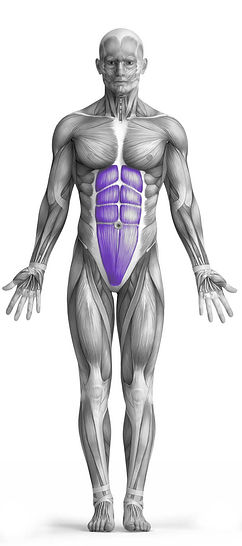Ab Crunch 101 Video Tutorial
0

Exercise Synopsis
Target Muscle Group
Abs
Secondary Targets
None
Execution
Isolation
Force Type
Pull (Bilateral)
Required Equipment
Bodyweight
Fitness Level
Beginner
Variations
None
Alternatives
None
Timer
Hour
Minute
Second
Stopwatch
00:00:00:00
Overview
The "Ab Crunch" is a core-strengthening exercise primarily targeting the abdominal muscles. It is performed by lying on your back with your knees bent and feet flat on the floor, then curling your upper body towards your knees using the strength of your abs. The movement should be controlled, focusing on squeezing the abs at the peak of the crunch before slowly returning to the starting position. This exercise requires no equipment, relying solely on bodyweight for resistance, making it a convenient and effective addition to any workout routine aimed at improving abdominal strength and definition.
How to Perform
Start by lying on your back with your knees bent and feet flat on the floor, keeping your arms crossed over your chest or placed gently behind your head for support.
Take a deep breath in, then exhale as you engage your core, using your abdominal muscles to lift your upper body off the floor.
Continue curling your torso upwards until your upper back is slightly off the ground, ensuring your movement is controlled and your abs are fully contracted.
Slowly reverse the movement, lowering your upper body back down to the starting position with a focus on maintaining tension in your abs throughout.
Repeat the movement for the designated number of repetitions, making sure to maintain proper form and avoid using momentum.
★ Bonus: For exercises that involve external weights (such as dumbbells, barbells, or machines), the One Rep Max (1RM) calculator can help you estimate your maximum lifting capacity. Use it to track your strength progress and adjust your training for optimal results.
Tips
As you exhale, imagine forcefully blowing out candles on a cake, engaging your core muscles, and hold the contraction for a brief moment to strengthen the mind-muscle connection.
If you experience discomfort in your lower back while performing this exercise, consider switching to movements that focus on anti-extension and anti-rotation to protect your spine.
Avoid placing your hands behind your head during the exercise, as this can put unnecessary strain on your neck and reduce the effectiveness of the movement.
How Not to Perform
Avoid Using Momentum: Do not jerk or swing your body to lift yourself. Rely on your abdominal muscles to initiate the movement, and keep the motion slow and controlled to avoid wasting energy and reducing the effectiveness of the exercise.
Don’t Strain Your Neck: Keep your neck relaxed throughout the movement. Avoid pulling your head or neck forward with your hands, as this can cause strain. Instead, keep your hands lightly across your chest or placed gently behind your head without using them to assist the movement.
Do Not Overextend Your Lower Back: Keep your lower back pressed into the floor throughout the exercise. If your lower back starts to arch, it could indicate improper form, which may lead to discomfort or injury. Engage your core to stabilize your spine.
Avoid Rushing the Movement: Perform the crunch in a slow, controlled manner, focusing on contracting your abs rather than completing the set as quickly as possible. Rushing can lead to inefficient activation of the target muscles and increase the risk of injury.
Don’t Lift Too High: Only lift your upper body enough to fully engage your abs. Going too high can reduce the effectiveness of the exercise and strain your lower back. Focus on the contraction in your core, not on how far you can lift your torso.
Don’t Hold Your Breath: Avoid holding your breath during the exercise. Instead, focus on exhaling as you curl up and inhaling as you lower back down, maintaining a steady breathing pattern to optimize performance and reduce unnecessary tension.
Don’t Use Your Arms to Push: Your arms should remain relaxed, either crossed over your chest or lightly behind your head. Do not use your arms to push or assist in the movement, as this will shift the focus away from your abs and lead to wasted energy.
Variations
Variations of fitness exercises refer to different ways of performing a specific exercise or movement to target various muscle groups, intensities, or goals. These variations aim to challenge the body differently, prevent plateaus, and cater to individuals with varying fitness levels.
Alternatives
Alternative exercises in fitness refer to different movements or activities that target similar muscle groups or serve the same training purpose as the primary exercise. These alternative exercises can be used as substitutes when the original exercise is unavailable or challenging to perform due to various reasons such as equipment limitations, injuries, or personal preferences.








